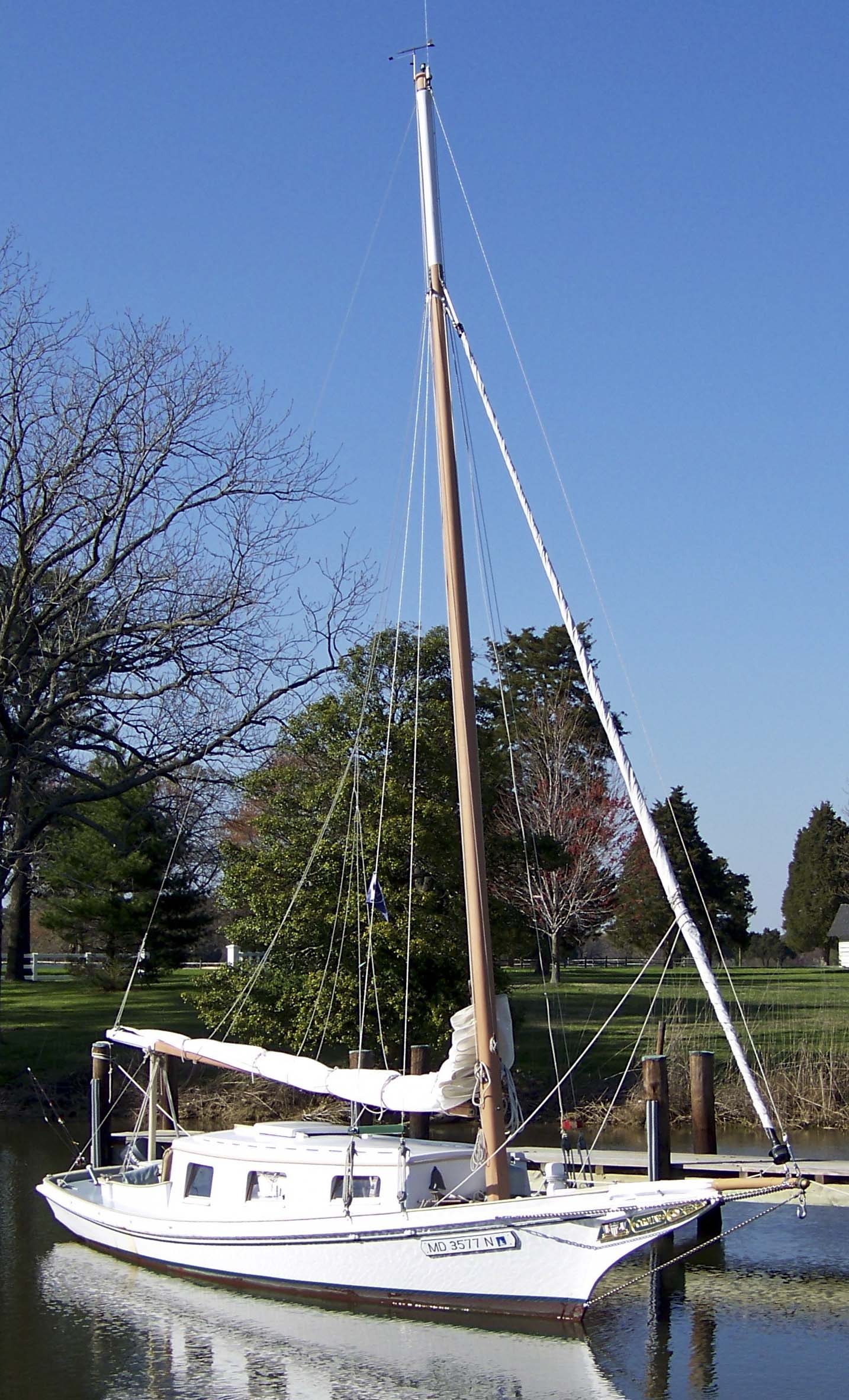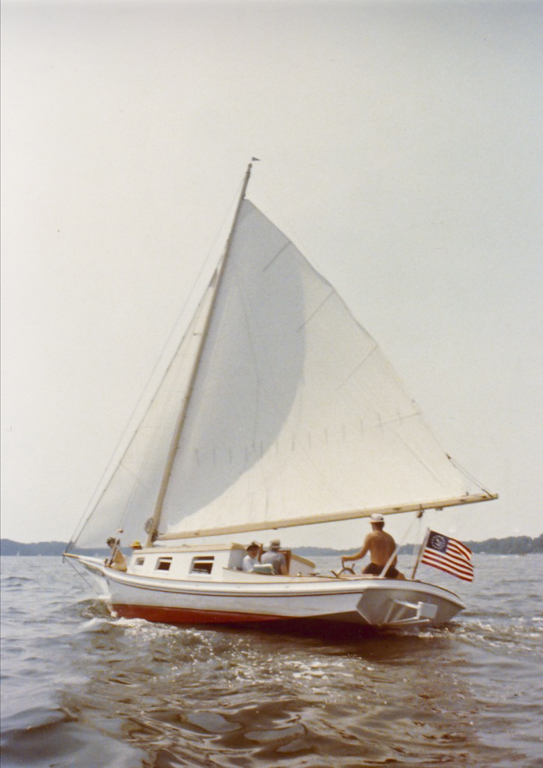Caroline
Status
Updated 23 June 2024:
Caroline is a privately owned, recreational skipjack.


Updated 23 June 2024:
Caroline is a privately owned, recreational skipjack.

The following story of Caroline's early years was written by her builder, John Layng, and provided to the Last Skipjacks Project by owner as of 2016, Roo Wood: [Note: Inconsistency of spelling of Lizzy D/Lizzie D is as provided.]
The skipjack named "Caroline" was earlier known as the "Lizzy D." The Lizzy D was built by John Fletcher Layng III on the shores of the Severn River at Round Bay in the 1960s.
The Layng Family has been in Maryland and traveling by boat on the Chesapeake Bay and its tributaries for over a century. The Layng grandfather, known as "Daddy Layng," was a consulting engineer. He came to Maryland in the late 19th Century to electrify the Baltimore and Annapolis Railroad. The Layngs settled at Round Bay on the Severn River, next door to the Edward Smiths, John's maternal grandparents. The Smiths and the Layngs always had boats and often took picnic excursions together. Mr. Smith, known as "Pop," would travel by steamboat down the Chesapeake Bay from Baltimore to Norfolk on business.
In 1920 Daddy Layng bought a 42-foot Potomac River Nancy from the builder John Chiseldine. A Nancy was a sailing boat with a big centerboard and two masts, one at the bow and one amidships. The schooner was rigged with no head sails or jib. It was probably gaff rigged. It had a small open cabin and a rounded stern. Daddy Layng converted the Nancy, known as the "Captain John," for its builder John Chiseldine, into a comfortable cabin cruiser with a Palmer Engine.
The Layng family would cruise up and down the Chesapeake Bay in the Captain John. When Daddy Layng died, ownership went to John's father, John Fletcher Layng, Junior. John and his two sisters have many fond memories of overnight Bay cruises on the Captain John. One time, when John was only ten, he singlehandedly took the Captain John to Annapolis from Round Bay, steering through the narrow drawbridges near Annapolis. John docked the boat at a boatyard in Eastport and met his father who had driven there by car.
With this background, it is not surprising that John Fletcher Layng III would build a Chesapeake Bay Skipjack. John started this endeavor in 1964 in the woods up behind his parents' house at Round Bay on the Severn River. John was inspired by Howard I. Chapelle's book "American Small Sailing Craft," which had the plans for building a full-scale skipjack. John modeled his boat after the 36-foot Messenger, illustrated in Chapelle's book, scaling down his own skipjack to 28 feet on deck and changing to an inboard rudder. It took time for John to gather materials for his skipjack, John wanting to do everything right. John knew what he wanted and he selected mahogany for the sides and cypress for the bottom, making the circuit of area lumber yards and sawmills to get just the right wood for a certain job.
Twice, John went out into the woods and sawed down trees for a mast. Twice, he rejected these masts as too heavy for the boat. Instead John pieced lumber to build a mast that would help to balance the hull in its graceful line in the water.
That John was building a skipjack in the woods behind his parents' house became well known in the community. Family and friends would greet John by asking: "How's the boat coming along?" When John got married in 1965 and moved away from Round Bay, the boatbuilding slowed for lack of time and money. John would continue to come down to the family homestead on the Severn, but often his father would have chores for John to do around the yard before he could get to his boat.
By 1970, John had the skipjack hull ready to launch. John and his father "Jack" and his mother's brother Russell Smith helped to roll the boat on pipes from the woods down to the Severn River. First they had to dig out a large azalea bush and a hemlock tree to get them out of the way to get the boat from the woods into the yard. Then they had to roll the boat across a long sloping lawn down to the water's edge. At the beach, John had to build a plank runner to lower the boat over a stone seawall and into the water. All of this was done over a period of several days.

On 1 August 1970, John held a christening party for his skipjack at the Layng family beach. Family and friends gathered for a champagne celebration, while John named his boat the "Lizzie D" after his mother-in-law, Elizabeth Dawson.
In the following years, John built a cabin for the skipjack and added other amenities. He carved trailboards for the boat and anchored it out front of his parents' house at Round Bay. Everyone loved it!
In John's own words for the specifics of his skipjack, the material he used, and his construction process:
Skipjack Lizzie D:
Length on deck: 28'
Length with bowsprit: 34'
Beam: 9'
Draft: 2' Board up, 6' Board down
Material:
Long timbers of longleaf yellow pine from Condon Lumber Co., White Plains, N.Y.
White oak for framing from local saw mill.
Mahogany for side planking and transom from local lumber yards.
Cypress bottom planking from local lumber yards.
Bottom nailed with bronze ring nails.
Side planking, strip planked, edge nailed and glued, screwed to frame with bronze screws covered with wood plugs.
Decks - plywood covered with fiber glass.
Long bolts made of Naval Bronze Rod.
Metal parts fabricated in metal shop at work. Also melted and cast lead ballast at work.
Building the skipjack:
"Started construction in an upright position. Built keel, stem, transom, gunnels, chines, strong backs and oak ribs. Started side planking. At this time I turned the boat upside down to finish planking and to install bottom planking. With this done I turned her back over to work on the decks, build long heads, bow spril, gunnels and rail cap. Installed rudder and centerboard. Lead ballast made from melted lead wheel weights.
"I got married in 1965, which reduced time and money available for boat building. Continued work at a slower pace until launching in 1970.
"After launching made steering gear from a Chevrolet automobile and steering wheel from an abandoned skipjack. Fabricated mast and boom from clear fir planks. Mast 36'. Boom 20'. Had sails made by Charles Ulmer Sailmakers in Annapolis. Main 300 square feet. Jib 100 square feet.
"Added a cabin for cruising. Sailed, cruised and raced successfully until 1992. At this time, my wife took ill and I had to let the boat go. It was donated to the Chesapeake Bay Maritime Museum. It was later acquired by Roo Wood. He has maintained her very well and sails her regularly year round to the present day."
For twenty-two years, John sailed the Severn River and the Chesapeake Bay in his skipjack. The boat sailed so smoothly along with John steering and he deftly grabbed the buoy upon returning to anchorage.
John and his family and friends took many cruises on the Chesapeake Bay in the Lizzie D. John sailed up to the head of the Bay at Havre de Grace and Bainbridge. He sailed down the Bay to the Potomac River and to St. Mary's City twice. John says he always was limited in how far he could go, because he had to have time to come back. He would go out for nine days: four days out and four or more days back. He explored along the way. John always towed a rowboat so that he could go ashore, which did not add to his sailing speed.
The Lizzie D was picturesque and much photographed by family and friends while she was moored in Round Bay on the Severn River. John's father "Jack Layng" took the [above] photograph in 1978 with the builder John Layng at the helm. John's mother Marjorie Smith Layng, uncle Russell Smith, with Betty Layng, and son Mark Layng were on board the skipjack in this photo.
However, time changes many things. By 1992 John's wife had a series of seizures and it was too much for John to care for his wife and care for his boat. Around that time John gave his skipjack to the Chesapeake Bay Maritime Museum in St. Michaels, Maryland. The Museum then auctioned off the Lizzie D, which led to a newer era and a new story of the skipjack known as "Caroline."
To continue Caroline's story, the person who bought her from the museum was not a sailor, and eventually a neighbor accepted her in lieu of payment for some construction work.
Around 1998, Roo Wood bought her, wanting a boat that he could singlehand and for his kids. He said she did not need a lot of structural work when he bought her, even though she had been sitting on the bottom for a while. He did some interior work on her and installed a roller furling jib to allow him to handle the boat by himself.
He named the boat Caroline after his daughter, and a friend, Kim Fillipo, wrote a poem for the boat's christening:
The Two Carolines
Dancing, swaying almost laughing,
Gently her sails lift him out of the harbor of family
and into the softly flowing swells of the sea.
The child, the ship both captivate the heart of this man of the sea.
The ship full of adventure leads him away
to destinations of mystery and solitude,
yet the child, whose light so shines,
always calls and guides her sailor-father home.
Twenty years later, he was still sailing Caroline, even using her in a corporate ad with a crew dressed up in gorilla suits. Marine surveyor Fred Hechlinger liked the boat, describing her as "one of the best I've seen." We have had no updates on her since 2016, so her current status is uncertain.